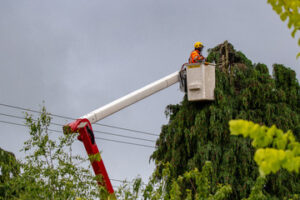Tree Removal is a huge job, but not all tree removals are the same. Some cities require permits to remove certain types of trees. In some countries, you need to have a permit to cut down trees two feet above the ground or more than 56 inches in circumference. Permits can be obtained from local arborists who know the local laws and regulations.

Tree Removal provides services for a variety of different reasons. For example, they can remove dead trees that pests or diseases have damaged. They may also remove trees if you are trying to resell your home. If you are trying to raise money for new development, it would be wise first to hire a professional tree removal company to ensure that the development is not negatively affected by dead trees on the property.
In some cases, a tree needs to be removed for various reasons. The homeowner can take certain steps to prepare for the removal, such as clearing an area around the tree so that it can lay flat when it comes down. This will ensure that there is no damage to the surrounding areas. When choosing a tree removal service, research the different options and select the right one for your project.
If you’re considering removing a tree from your yard, ensure you have an alternate way to access your yard. Also, ensure that the tree you’re planning to remove is in an appropriate location. This is important because if a tree is in the wrong location, it can grow too large and become a nuisance. If the tree is near a driveway, you may need a protective barrier between the roots and the driveway.
The size and location of the tree will also affect the cost of tree removal. A tree far from any structure will cost less than one near a building or power line. Also, the size and condition of the tree will determine the overall expense. The larger and taller the tree, the more expensive the removal will be.
The tree removal process begins with a plan devised by an arborist. First, an arborist will secure a rope or cable around the trunk. A ground worker will guide the rope. Then, the tree will be cut down into sections. An arborist must know when and where to cut notches so the tree won’t fall.
If a tree is causing damage to a building, you should contact a tree removal service. Tree removal is a dangerous job, and if you’re unsure about the procedures, it’s best to leave it to the professionals. However, if the tree is close to your home, it’s best to wait until late winter, when leaves will have fallen.
Depending on how tall the tree is, it may cost a couple of hundred dollars to remove it. Larger trees, on the other hand, can cost upwards of $1,500 or more. Larger trees require a lot of heavy machinery and disposal material. This will affect the price of the service. Tree removal services also charge extra for stump removal.
If you have a stump, the cost of stump removal will depend on the size and root system of the tree. You can save money by hiring a stump grinding service if the stump is small and not too large. If the stump is small in diameter, you can rent a stump grinder at a hardware store for about $75. Chemical treatment of the stump is another option.
Another important reason why it is important to hire a tree removal company is so that the utility wires can safely be removed. This is because some trees can grow branches or even needles which can get tangled up with utility wires. It is often difficult for people to clean up these wires when they fell from a tree. Therefore, the professionals need to do this job promptly to ensure that no one experiences any type of inconvenience due to the tangled wires.

